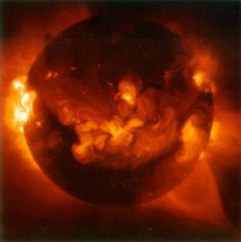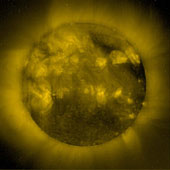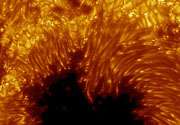
![]() Main Page
Main Page
![]() Feedback
Feedback
 The Author
The Author
 News
News
 Search
Search
 The Planets
The Planets
 Mercury
Mercury
 Venus
Venus
 Earth
Earth
 Mars
Mars
 Jupiter
Jupiter
 Saturn
Saturn
 Uranus
Uranus
 Neptune
Neptune
 Pluto
Pluto
 Dwarf Planets
Dwarf Planets
 The Solar System
The Solar System
 The Sun
The Sun
 The Moon
The Moon
 Meteors
Meteors
 Comets
Comets
 Asteroids
Asteroids
 Amazing facts
Amazing facts
 Other
Resources
Other
Resources
 Poster Store
Poster Store
 Multimedia
Multimedia
 Links
Links
 Awards
Awards
 Glossary
Glossary
 Astronomers
Astronomers
 Webrings
Webrings
 Bibliography
Bibliography

Technical Data:-
| Spectoral Type of Star | G2 V |
| Age | 4,600 million Years |
| Mean Distance to Earth | 150 Million Kilometres (1 AU) |
| Rotation Period (equator) | 26.8 Earth days |
| Radius | 695,000 km |
| Composition | 71% Hydrogen 26.5% Helium 2.5% Other |
| Mass | 1.99 x 1030 Kilograms |
| Effective Surface Temperature | 6,000o C |
| Core Temperature | 15 milliono C |
| Luminosity [Energy Output] | 3.83 x 1033 ergs / second |
| Solar Constant | 0.137Watts/cm2 |
| Inclination of Solar Equator to Ecliptic | 7.25o |
More pictures of the Sun Here |
Print this information out Here |
|||||||||||||
| ||||||||||||||
The Sun is our closest star and the centre of the Solar System. It is around four and a half thousand million years old and in 6 thousand million years or so, it is predicted that it will reach the end of its life (more on that further down). Currently however, it is an 'average' sized star, classified as a G2 type main sequence star. These can be found quite abundantly throughout the visible universe. However, don't let this apparent 'normalness' of the Sun's size in comparison with other stars fool you - compared with anything else in our solar system, it is absolutely superlative. To give you an idea of its size, it has 333,400 times more mass than the Earth and contains 99.86% of the mass of the entire Solar System - this means Jupiter and all the other planets and asteroids put together only account for 0.14% of the mass of the Solar System. The Sun's core is so hot and dense that just a pinhead of its material could kill a person 160 kilometres away.
Every second the Sun loses 4.5 million tonnes of material, blown off to space - this means that in 42 million years it would lose enough material to make the Earth. However this high loss rate of mass is really rather insignificant when compared to the total mass of the Sun - over the past 4,500 million years it has barely lost a few hundredths of a percent of its total mass. Interestingly, all the light we see from the Sun comes from a layer 500km deep (the top 0.1%) and takes about 8.3 minutes to reach us down here on Earth. By contrast, radiation from its core takes about 170,000 years to make its way out to the surface, due to the high density of the mass it must travel through. Under the Microscope and The Corona Viewed from the surface of the Earth, to normal human beings the Sun appears to be a simple, round uniform yellow ball. When observed in detail however, as the pictures show, this is far from being the case. In reality it has several well-defined layers leading up its surface, and above its surface it even has what could be termed it's atmosphere - the mystifyingly scorching hot solar corona. An imaginary solar 'tourist', travelling out from the centre of the Sun, would begin his journey at a sweltering 15.6million░K in the core, gradually decreasing as he got further from the centre, eventually reaching just 5780 or so Kelvins in the photosphere - the Sun's 'surface'. However, the temperature would then begin to increase as he progresses through the Chromosphere, up to 10,000K, culminating in an a massive 1 million K (or higher) in the corona! The exact reason for this unexpectedly high temperature in the corona is still unknown, though recent research has ascertained that the energy needed to heat the corona to such high temperatures is somehow provided by the Sun's vast magnetic field.
The Sun was born, as I mentioned earlier, about 4.5 thousand million years ago. Like all stars, it was formed when a cloud of gas of at least 100 Solar Masses, floating around the galaxy, got squeezed by an outside influence (e.g. a nearby supernova explosion or the pressure of a passing spiral arm of the galaxy) and started to collapse. After a while, the cloud (or 'nebula') would have reached a point at which it continued collapsing under its own weight, breaking up in the process to form many different stars. As the part that was to be the Sun collapsed further, it became more and more dense and increased in temperature. Under the increasingly strong influence of a central gravitational force, the mass would soon have formed a spherical shape, and when the temperature in the centre reached about 15 million░C, it got hot enough for nuclear reactions to start. The outward force created by these reactions acted as a stabilizing influence on the star, preventing further collapse, so the star eventually reached an equilibrium. The Sun is now a stable star, though gradually increasing in luminosity. It is presently 'burning' hydrogen in its core, converting it into Helium by a nuclear fusion process. And here's where the extremely high temperature and pressure present in the core of the Sun comes in, for these conditions make it impossible for whole atoms to exist - instead the protons and electrons forming atoms are free to move sperately, thereby forming a plasma in the Solar core. The immense pressure of the Sun's weight then acts to push the protons and electrons closer together than they would be normally, and eventually to fuse together 4 Hydrogen nuclei (ie 4 protons), in a number of stages, to end up with 1 helium nucleus (ie 2 protons and 2 neutrons).
In fact about 700 million tons of Hydrogen are converted to Helium every second, releasing 5 million tons of pure energy. However nuclear fusion can only keep happening for another four thousand million years or so, when Hydrogen will then run out in the core. When this happens the inner core will shrink and the Sun will expand and get hotter, due to Hydrogen being 'burned' in the outer core, engulfing Mercury and nearly reaching Venus. As it does so, the core will reach a blistering 100 million░C and will begin to burn the Helium there. This will keep the star stable as a 'Red Giant' for a thousand million years or so until the Helium runs out. When this happens, the core will begin collapsing again and it'll get hotter and the star will get bigger once more, expanding to the present orbit of Earth. At this point, the Sun will be very unstable, expanding and shrinking often and losing a lot of material into space. Soon afterwards, all that will be left will be its inner Carbon core, which, although it will still contain about 2 thirds of the Sun's mass, will be collapsed so much that it will have reached the ultimate density, quantum forces will stop it collapsing further and it'll become a 'White Dwarf' - a small star about the size of the Earth but much denser (about 1cm3 of this stuff would have the mass of a tonne - that's a million times the density of water!) The European Space Agency and NASA are operating the SOHO (which was successfully launched in 1995) satellite and ESA will soon launch the Cluster II. This is finding out about how the Sun interacts with the Earth. The SOHO (SOlar and Heliospheric Observatory) telescope is studying and staring at the Sun while the Cluster II will study the Earth and the effects the Sun has on it. |
||||||||||||||
Brief History:- |
||||||||||||||
The Sun's first solar eclipse was predicted in 585BC and over 2000 years later, in 1610 Galileo first saw sunspots using his newly-refined telescope. In 1868 Helium lines were first observed in the Solar Spectrum and in 1946 the 1million K temperature of the corona was discovered. The first direct observations of solar wind however were not made until 1959 by the Mariner 2. Quite recently though, in 1995 the Ulysses flew over the polar regions of the Sun. |
||||||||||||||
The Sun Links |
||||||||||||||
|
||||||||||||||

Sun Chart -
Buy this Poster at AllPosters.com



